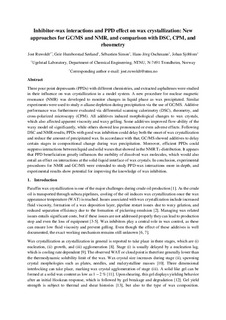| dc.contributor.author | Ruwoldt, Jost | |
| dc.contributor.author | Sørland, Geir | |
| dc.contributor.author | Simon, Sebastien Charles | |
| dc.contributor.author | Oschmann, Hans-Jörg | |
| dc.contributor.author | Sjøblom, Johan | |
| dc.date.accessioned | 2019-02-26T12:44:46Z | |
| dc.date.available | 2019-02-26T12:44:46Z | |
| dc.date.created | 2019-02-22T12:50:11Z | |
| dc.date.issued | 2019 | |
| dc.identifier.citation | Journal of Petroleum Science and Engineering. 2019, 177 53-68. | nb_NO |
| dc.identifier.issn | 0920-4105 | |
| dc.identifier.uri | http://hdl.handle.net/11250/2587490 | |
| dc.description.abstract | Three pour point depressants (PPDs) with different chemistries, and extracted asphaltenes were studied in their influence on wax crystallization in a model system. A new procedure for nuclear magnetic resonance (NMR) was developed to monitor changes in liquid phase as wax precipitated. Similar experiments were used to study nalkane depletion during precipitation via the use of GC/MS. Additive performance was furthermore evaluated via differential scanning calorimetry (DSC), rheometry, and cross-polarized microscopy (CPM). All additives induced morphological changes to wax crystals, which also affected apparent viscosity and waxy gelling. Some additives improved flow-ability of the waxy model oil significantly, while others showed less pronounced or even adverse effects. Following DSC and NMR results, PPDs with good wax inhibition could delay both the onset of wax crystallization and reduce the amount of precipitated wax. In accordance with that, GC/MS showed additives to delay certain stages in compositional change during wax precipitation. Moreover, efficient PPDs could suppress interactions between liquid and solid waxes that showed in the NMR T2-distribution. It appears that PPD beneficiation greatly influences the mobility of dissolved wax molecules, which would also entail an effect on interactions at the solid-liquid interface of wax crystals. In conclusion, experimental procedures for NMR and GC/MS were extended to study PPD-wax interactions more in-depth, and experimental results show potential for improving the knowledge of wax inhibition. | nb_NO |
| dc.language.iso | eng | nb_NO |
| dc.publisher | Elsevier | nb_NO |
| dc.relation.uri | https://www.sciencedirect.com/science/article/pii/S0920410519301834?via%3Dihub | |
| dc.rights | Attribution-NonCommercial-NoDerivatives 4.0 Internasjonal | * |
| dc.rights.uri | http://creativecommons.org/licenses/by-nc-nd/4.0/deed.no | * |
| dc.title | Inhibitor-wax interactions and PPD effect on wax crystallization: New approaches for GC/MS and NMR, and comparison with DSC, CPM, and rheometry | nb_NO |
| dc.type | Journal article | nb_NO |
| dc.type | Peer reviewed | nb_NO |
| dc.description.version | acceptedVersion | nb_NO |
| dc.source.pagenumber | 53-68 | nb_NO |
| dc.source.volume | 177 | nb_NO |
| dc.source.journal | Journal of Petroleum Science and Engineering | nb_NO |
| dc.identifier.doi | 10.1016/j.petrol.2019.02.046 | |
| dc.identifier.cristin | 1679848 | |
| dc.relation.project | Norges forskningsråd: 237893 | nb_NO |
| dc.description.localcode | © 2019. This is the authors’ accepted and refereed manuscript to the article. Locked until 15.02.2021 due to copyright restrictions. This manuscript version is made available under the CC-BY-NC-ND 4.0 license http://creativecommons.org/licenses/by-nc-nd/4.0/ | nb_NO |
| cristin.unitcode | 194,66,30,0 | |
| cristin.unitname | Institutt for kjemisk prosessteknologi | |
| cristin.ispublished | true | |
| cristin.fulltext | original | |
| cristin.fulltext | postprint | |
| cristin.qualitycode | 2 | |

